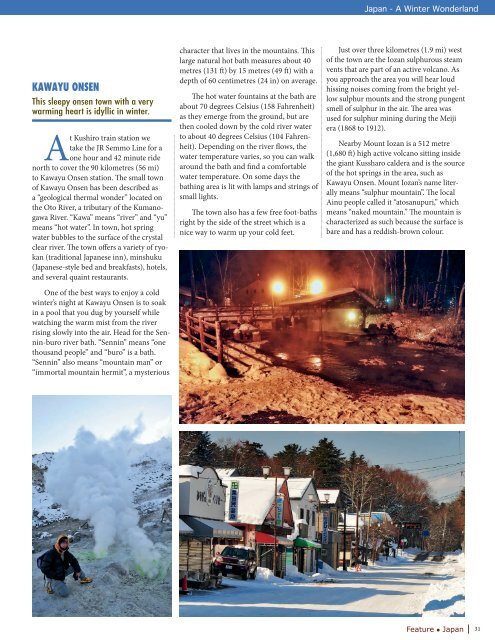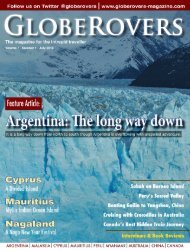GlobeRovers Magazine, Dec 2019
GLOBEROVERS MAGAZINE IS NO LONGER ALLOWED TO HAVE MORE THAN 3 ISSUES ON YUMPU UNLESS WE PAY (to provide revenue-generating content to Yumpu!!) SO PLEASE SEE ALL OUR ISSUES FOR FREE ON THESE MAGAZINE PLATFORMS: CALAMEO, MAGZTER, AND ON THE FREE "globerovers" APP.
GLOBEROVERS MAGAZINE IS NO LONGER ALLOWED TO HAVE MORE THAN 3 ISSUES ON YUMPU UNLESS WE PAY (to provide revenue-generating content to Yumpu!!) SO PLEASE SEE ALL OUR ISSUES FOR FREE ON THESE MAGAZINE PLATFORMS: CALAMEO, MAGZTER, AND ON THE FREE "globerovers" APP.
You also want an ePaper? Increase the reach of your titles
YUMPU automatically turns print PDFs into web optimized ePapers that Google loves.
Japan - A Winter Wonderland<br />
KAWAYU ONSEN<br />
This sleepy onsen town with a very<br />
warming heart is idyllic in winter.<br />
At Kushiro train station we<br />
take the JR Semmo Line for a<br />
one hour and 42 minute ride<br />
north to cover the 90 kilometres (56 mi)<br />
to Kawayu Onsen station. The small town<br />
of Kawayu Onsen has been described as<br />
a “geological thermal wonder” located on<br />
the Oto River, a tributary of the Kumanogawa<br />
River. “Kawa” means “river” and “yu”<br />
means “hot water”. In town, hot spring<br />
water bubbles to the surface of the crystal<br />
clear river. The town offers a variety of ryokan<br />
(traditional Japanese inn), minshuku<br />
(Japanese-style bed and breakfasts), hotels,<br />
and several quaint restaurants.<br />
One of the best ways to enjoy a cold<br />
winter’s night at Kawayu Onsen is to soak<br />
in a pool that you dug by yourself while<br />
watching the warm mist from the river<br />
rising slowly into the air. Head for the Sennin-buro<br />
river bath. “Sennin” means “one<br />
thousand people” and “buro” is a bath.<br />
“Sennin” also means “mountain man” or<br />
“immortal mountain hermit”, a mysterious<br />
character that lives in the mountains. This<br />
large natural hot bath measures about 40<br />
metres (131 ft) by 15 metres (49 ft) with a<br />
depth of 60 centimetres (24 in) on average.<br />
The hot water fountains at the bath are<br />
about 70 degrees Celsius (158 Fahrenheit)<br />
as they emerge from the ground, but are<br />
then cooled down by the cold river water<br />
to about 40 degrees Celsius (104 Fahrenheit).<br />
Depending on the river flows, the<br />
water temperature varies, so you can walk<br />
around the bath and find a comfortable<br />
water temperature. On some days the<br />
bathing area is lit with lamps and strings of<br />
small lights.<br />
The town also has a few free foot-baths<br />
right by the side of the street which is a<br />
nice way to warm up your cold feet.<br />
Just over three kilometres (1.9 mi) west<br />
of the town are the Iozan sulphurous steam<br />
vents that are part of an active volcano. As<br />
you approach the area you will hear loud<br />
hissing noises coming from the bright yellow<br />
sulphur mounts and the strong pungent<br />
smell of sulphur in the air. The area was<br />
used for sulphur mining during the Meiji<br />
era (1868 to 1912).<br />
Nearby Mount Iozan is a 512 metre<br />
(1,680 ft) high active volcano sitting inside<br />
the giant Kussharo caldera and is the source<br />
of the hot springs in the area, such as<br />
Kawayu Onsen. Mount Iozan’s name literally<br />
means “sulphur mountain”. The local<br />
Ainu people called it “atosanupuri,” which<br />
means “naked mountain.” The mountain is<br />
characterized as such because the surface is<br />
bare and has a reddish-brown colour.<br />
Feature • Japan | 31





